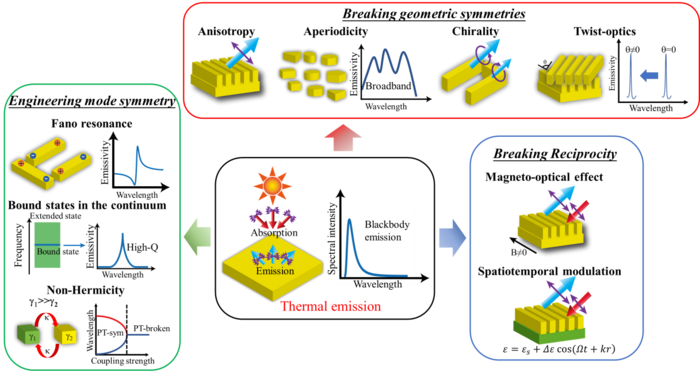Radiative heat transfer is a ubiquitous physical process in our universe. Any object with a temperature above absolute zero exchanges thermal energy with the environment. In physics, thermal emission originates from electromagnetic radiation induced by the thermal motion of charged particles inside materials. Planck’s law characterizes the spectral distribution of emitted power. The second law of thermodynamics governs the irreversibility of energy transfer in thermal emission. Thermal emission tends to be broadband, incoherent, omnidirectional, and unpolarized. That is due to fluctuating electromagnetic fields thermally generated inside materials.

Credit: by Tianji Liu, Cheng Guo, Wei Li, and Shanhui Fan
Radiative heat transfer is a ubiquitous physical process in our universe. Any object with a temperature above absolute zero exchanges thermal energy with the environment. In physics, thermal emission originates from electromagnetic radiation induced by the thermal motion of charged particles inside materials. Planck’s law characterizes the spectral distribution of emitted power. The second law of thermodynamics governs the irreversibility of energy transfer in thermal emission. Thermal emission tends to be broadband, incoherent, omnidirectional, and unpolarized. That is due to fluctuating electromagnetic fields thermally generated inside materials.
The rapid development of nanophotonics has seen researchers demonstrate that thermal emission, similar to spontaneous light emission, can be engineered or manipulated. It can be done using artificial or naturally occurring micro/nanostructures. Narrowband, directional, or polarized thermal emissions are all proposed and experimentally demonstrated using metamaterials. Fruitful achievements propel thermal photonics’ development, improving energy utilization efficiency and revolutionizing many energy applications.
In a new paper published in eLight, a collaborative team of scientists from Stanford University and Changchun Institute of Optics, Fine Mechanics and Physics, Chinese Academy of Sciences, led by Prof. Shanhui Fan and Prof. Wei Li, in their paper “Thermal photonics with broken symmetries,” emphasized the importance of broken symmetries for nanophotonic control of thermal emission and overviewed various physical phenomena and related applications.
Symmetries are of fundamental importance in physics. A symmetry of a physical system is a physical feature that remains invariant under some transformation. The transformations may be continuous or discrete, which give rise to the corresponding types of symmetries. Groups mathematically describe symmetries. Continuous symmetries are described by Lie groups, while finite groups describe discrete symmetries. The continuous symmetries of a physical system are intimately related to the conservation laws characterizing that system.
Symmetries also play an important role in thermal radiation. In this context, the relevant symmetries include the geometric and non-geometric ones. These symmetries have important implications for thermal radiation. For example, any thermal emitter is characterized by two key quantities: the angular spectral absorptivity and the angular spectral emissivity. It is known that the existence of geometric and non-geometric symmetries imposes direct constraints. Conversely, breaking these symmetries can remove such constraints. As a simple but important example, the researchers noted that any linear time-invariant thermal emitter needs to be lossy. As a result, they must break energy conservation and time-reversal symmetry. However, it can either obey or violate Lorentz reciprocity.
In summary, the researchers overviewed engineered nanophotonic structures with broken symmetries in thermal photonics, mainly concentrating on controlling thermal emission. They are distinct from conventional materials and nanophotonic structures with high symmetries. Broken geometrical symmetries are discussed, including anisotropy, aperiodicity, randomness, and chirality. This was an opportunity to highlight the geometrical asymmetry-induced control of thermal emission and other thermal effects. Another category of symmetry-breaking can be realized via engineering different mode symmetries, peculiar nanophotonic states, including Fano resonance and bound states in the continuum, are also feasible for thermal emission control. It enables narrowband emission and complete switching of thermal emission.
Reciprocity is a fundamental internal symmetry in electromagnetics. Breaking reciprocity in thermal photonics leads to nonreciprocal thermal emission, which can violate Kirchhoff’s law of thermal radiation and may improve the efficiency of energy conversion and harvesting applications. It does this by exploiting the magneto-optical effect and spatiotemporal modulation. For future development, introducing more compound broken symmetries and exploring the asymmetries in light-matter interactions may bring new research opportunities. Additionally, the team briefly discussed a few emerging directions: the non-Hermitian system and twist-optics.
Journal
eLight
DOI
10.1186/s43593-022-00025-z




